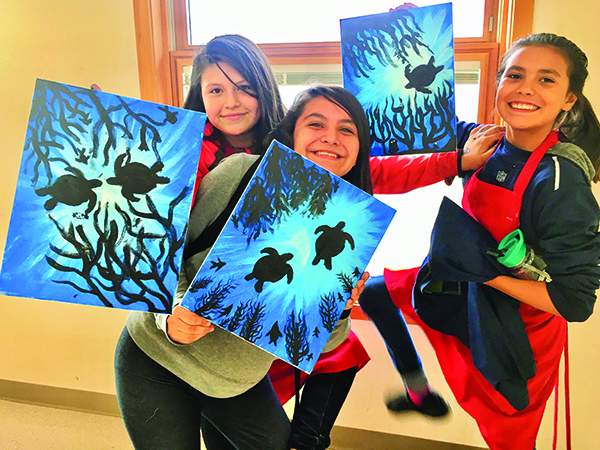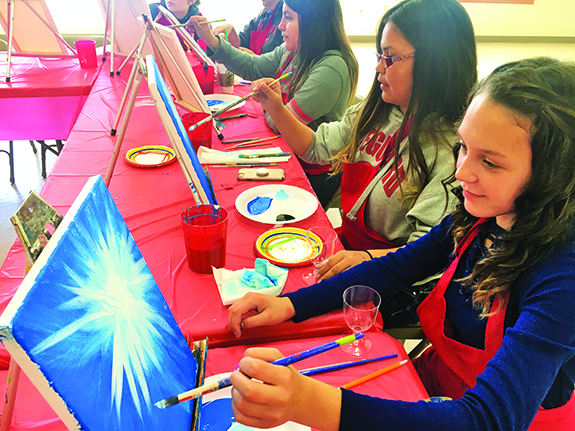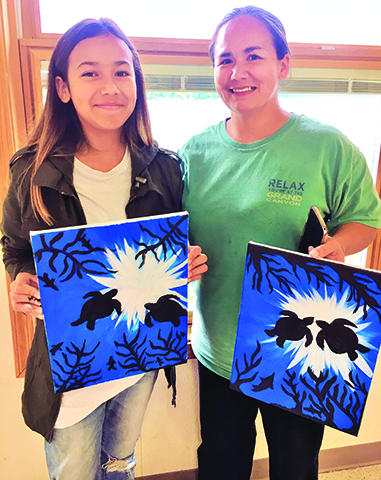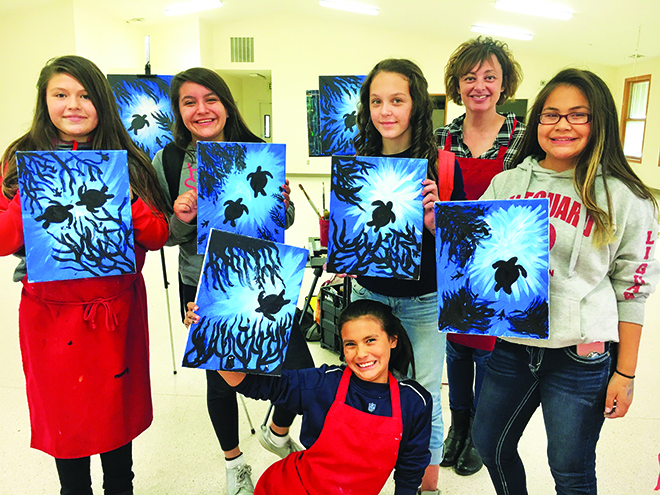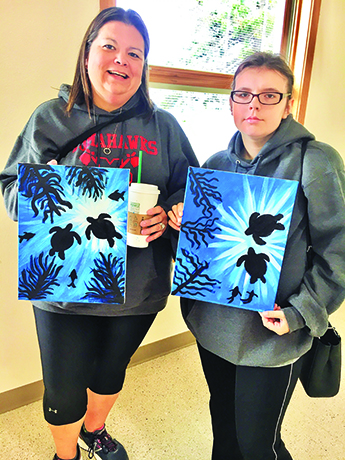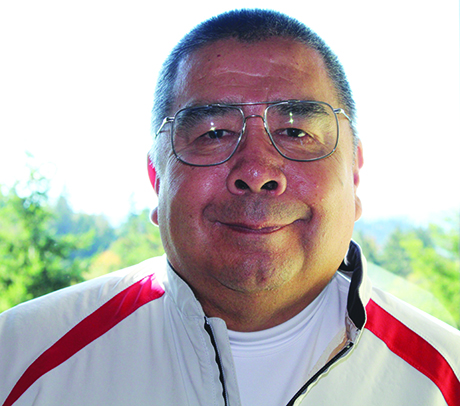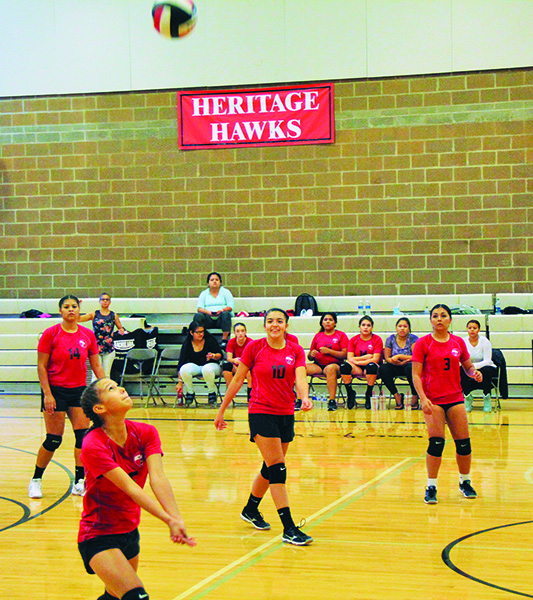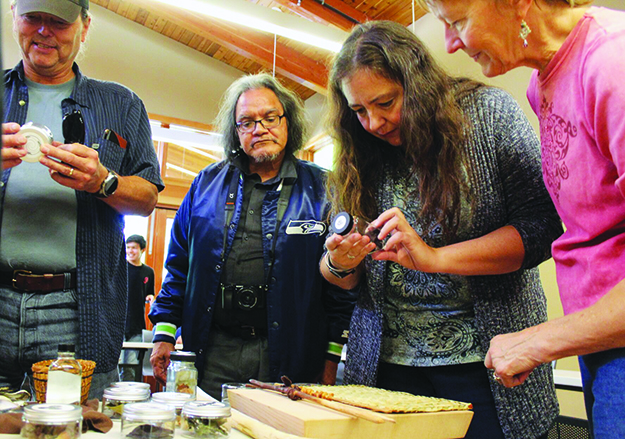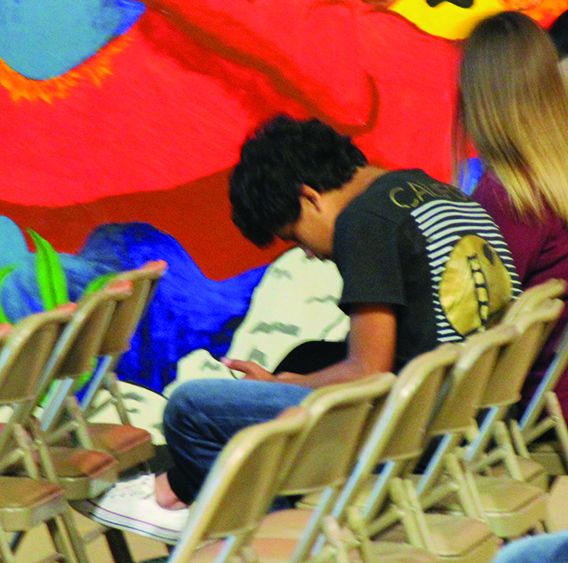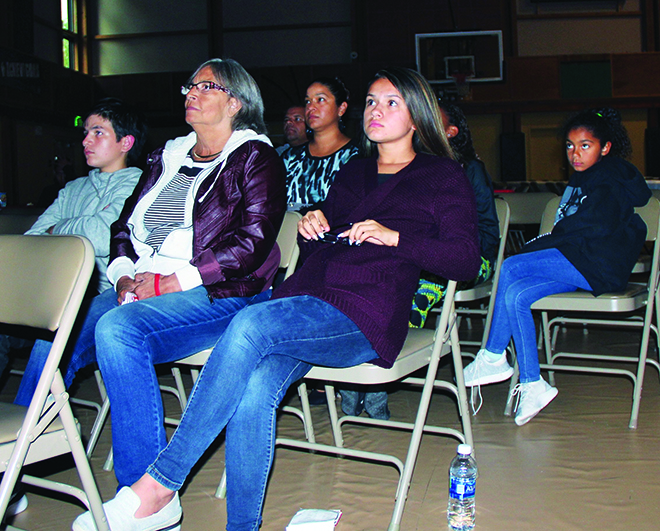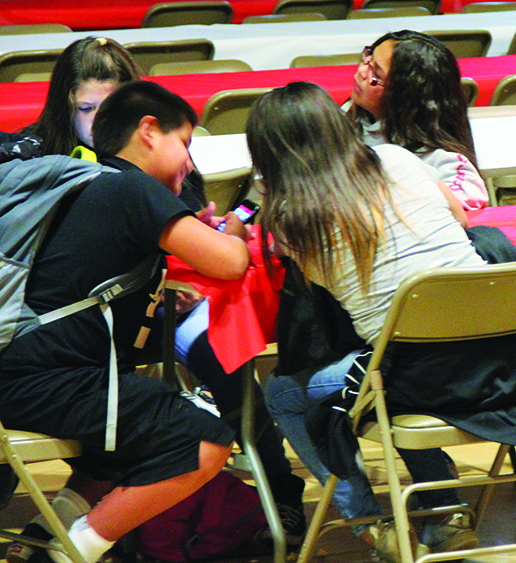Category: Tulalip News
TULALIP VIES TO BE HOME TO AMAZON’S “HQ2”
Tulalip offers Amazon sites in the first tribally chartered city in the United States
Tulalip is participating in this regional proposal with Snohomish and King County
TULALIP, WASHINGTON – Tulalip Tribes have partnered with regional leaders to persuade Amazon to build “HQ2” in Washington State. The Tulalip Tribes are offering large sites in Quil Ceda Village, the first tribally chartered city in the United States, as part of the joint bid announced on Thursday.
Tulalip Tribes leadership is confident Quil Ceda Village is a prime location for Amazon. It boasts buildable and appropriately zoned land, with a full suite of utilities and a location easily accessible to I-5. The Tulalip Tribe has also worked extensively with County and State officials to increase transportation capacity in the region.
“Amazon has proven themselves as forward thinking and the areas where they do business flourish,” said Marie Zackuse, Tribal Chairwoman. “We feel strongly that Amazon’s commitment to job growth, talent retention and their generous philanthropic culture aligns with Tulalip’s philosophy of looking forward, not only for our success, but for the success of our neighboring communities. “Amazon has been touted as ‘the world’s most customer centric company,’ and that generous focus on the long-term relationship with people, rather than short term profits, fits right in with our style of business, Zackuse continued.
“The Tulalip Tribes believe we all benefit when innovative companies make their home in our communities, Zackuse said. There are a wealth of positives for everyone involved that will occur from Amazon locating their second headquarters in our region, and this is why Tulalip is participating in this regional proposal with Snohomish and King County.
“Our teams are ready, the real estate is ready, and all that is left is a business that would best complement our ideals and our economy. We strongly believe, with Amazon, we’ve found that.”
For more information, visit www.tulaliptribes-nsn.gov.
Paint and Sip brings out inner artist for Girl’s Talking Circle
By Micheal Rios, Tulalip News; photos courtesy of event coordinator and para-pro, Monica Holmes
On the afternoon of Friday, September 29, the popular Paint and Sip experience came to Tulalip’s own Girl’s Talking Circle. Eight aspiring young ladies had the unique opportunity to create their own masterpiece on canvas while sipping sparkling cider and enjoying fancy snacks.
The Paint and Sip activity provided both our youth Girl’s Talking Circle and their family members with an opportunity to explore their creative side. They learned to hone their artistic skills, like utilizing color for effect, balancing light and dark, adding shapes, dimension and perspective, and taking risks to personalize art in order to make it their own.
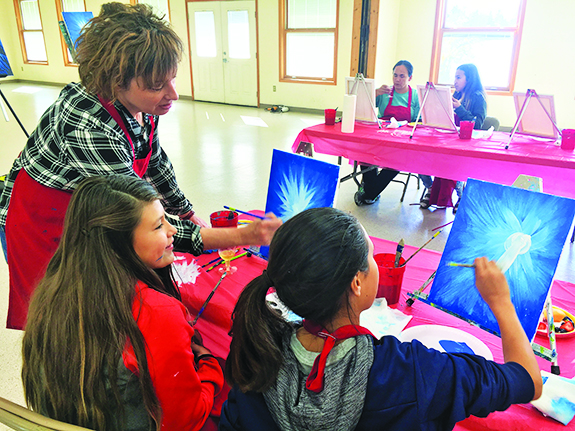
Hosted by Tulalip Youth Services and Behavioral Health’s MSPI Program, and held at the Kenny Moses Building, Paint and Sip was a creative way of engaging with female youth ages 11-18+. The mother, aunties, grandmas or female guardians of participating youth were also invited to participate. There ended up being two pairs of mother/daughter duos attending.
“One mother-daughter duo in particular really exemplified unity and support,” explains event coordinator and para-pro Monica Holmes. “Amy and Kelsey Sheldon reached out to us early on to see if we could create an inclusive activity that Kelsey could participate in. Kelsey has Autism and rarely has opportunities to interact with other young women her age with or without disabilities.
“Understanding the challenges Kelsey might face in groups, we felt including her mother Amy would be an important first step into helping Kelsey feel at ease in a group of new people. Sitting beside one another and working together on an art project helped to focus her attention to the task at hand. The finished product both mother and daughter created and the positive experiences they had, proves that kids with challenges and disabilities can benefit from more inclusion in community sponsored activities. MSPI (Methamphetamine Suicide Prevention Initiative) is working to push forward with even more tailored inclusive activities in which all youth can gain skills, camaraderie and connection to their heritage and community.”
For most of the girls Paint and Sip provided the opportunity to showcase their artistic talents on canvas for the very first time. Under the guidance of art instructor Irina Johnson from Vine and Palette, everyone painted their own rendition of sea turtles swimming in the ocean under a bright summer sun.
“Art teaches you to look at nature and everything around you through different eyes,” says artist Irina on the importance of experiencing art. “You look for details, texture, and color in a way that makes you appreciate all those things you generally ignore and take for granted. For example, how many colors can you spot in a leaf when the sun is setting, or what are all the textures in a tree branch, or the intricate details in a single blade of grass. All these little things add up to a greater awareness of our world and our reality. In this sense, art makes us appreciate life that much more.”
An eloquent description for sure, but for 11-year-old Tieriana McLean she puts it much simpler, “I came here because I just like painting.” What more need be said?
The Girl’s Talking Circle meets every Friday from 2:00 p.m.-4:00 p.m. at the Tulalip Youth Center. They do hands-on arts and crafts, explore cultural identity, focus on personal, team and community building, have speakers from the Tribe teach their wisdom, and go on fieldtrips to explore, learn and grow.
For more information about the Girl’s Talking Circle please contact Monica Holmes at 360-631-3406 or email: mholmes@tulaliptribes-nsn.gov
Ray Sheldon Jr. looks to bring fresh perspective to Marysville School District
By Kalvin Valdillez, Tulalip News
The Marysville School District (MSD) is comprised of twenty-two schools including ten elementary, four middle and eight high schools. The majority of Tulalip students attend schools within MSD as the entire reservation is under the school district. Tulalip is home to Quil Ceda Tulalip Elementary School, 10th Street Middle School, Tulalip Heritage High and Marysville Arts and Technology High School. MSD is split into five separate districts based on location, the Tulalip reservation is within and accounts for a large portion of District One. A representative from each district is elected by the community to serve on the school board every four years.
For the past eight years, Chris Nations has been the MSD District One Board of Director and is up for re-election this year. Tulalip tribal member, Ray Sheldon Jr. is challenging Chris for the District One seat and is progressively gaining more support as the election day of November 7 draws near. Ray has been actively involved within his community, coaching little league baseball for nearly thirty-five years. He also is a strong supporter for special needs children, volunteering his time to numerous non-profits including Leah’s Dream Foundation, an organization, founded by Tulalip member Deanna Sheldon, which assists local students with autism by raising funds, planning events and providing support to both parents and students.
“I’m an advocate for special needs and the kids that need care because I have four grandkids who are categorized as special needs,” Ray explains. “I don’t think the school district spends enough money for these people and kind of shoves them in the corner, which bothers me big time. I think we need to help those special needs children. Special needs doesn’t necessarily mean they’re stuck in a wheel chair, special needs are also the kids who have trouble reading or with dialect or anything else. The school doesn’t pay enough attention to them and we should start teaching and spending time with them.
“Budget-wise I feel they [MSD] just work for higher education,” he continues. “Those early years are really important. We should start in the beginning [of their education] and have therapists who are able to help these children. I think there really needs to be change with special needs education. It’s not just tribal children, its non-tribal too. We need representation for these children. We’re not getting it. We’re not getting it from Chris Nations, so we need to make a change so someone is there to represent our children.”
Former MSD board member, Don ‘Penoke’ Hatch, not only endorses Ray, but has been the main source of inspiration, providing the candidate with advice and encouragement throughout the race. In previous years, while Penoke served for MSD, community members voted only for their district representative; now community members can vote for all five district representatives. Ray believes that this procedure is flawed because it allows candidates to campaign outside of their district, therefore leaving many of the districts’ needs unattended when the candidate takes office.
“Don Hatch used to be on the school board. Years ago we used to visit on Saturday mornings, when he was a school board member, and he told me ‘when it’s time, you should take over because you care so much about the kids.’ He mentioned that he was getting up there in age but is still so passionate about it. I told him last spring that I really wanted to run this year. They changed the rules about district voting just before he left, so he told me it’d be an uphill battle. And it is an uphill battle, but he’s helping as much as he can. He’s inspired me to keep going and makes suggestions about where I can visit and help. My goal, if I get on, would be to make District One always a tribal district. That’s the way it should be. District One is a big district and since we’re a sovereign nation we should have that seat no matter what.”
During the 2016-2017 school year, MSD had just over 11,000 students attending their schools. Of those 11,000 students, six hundred and ninety-six were Native American and 1,749 students were special needs children. Over the course of recent years, MSD has slowly seen a decrease in attendance.
“We’re having a lot of children who are now leaving the school district and going to private schools,” Ray states. “I think sometimes they leave the school district because they’re not paid attention to, other than they’re just a number. Our future is really important, it’s important to have our children educated. It will be a better community and they’ll be great parents – that’s the whole dream. They can do it; they just need someone to make them understand that they can do it. This is the first year I coached the tribal baseball team, they just needed the confidence. I supplied that and they did really well, we only lost one game. All they lack is confidence and once you give them the confidence, they can do it. I think the teachers out here do their best because moneywise they can’t hire extra help. If we can better educate our people, maybe some of our issues will go away that we have in the community. I really think we need a Voc-Tech school in our high school area so the lower-tested kids can understand and learn a trade, like we do here with TERO.”
“There’s five districts, they meet a couple times each month and what bothers me the most is I’ve been to a few meetings and some of these members they’ll sit there and look at their watch and figure ‘we spent two hours here so it’s time to go’,” he expresses. “There are over 10,00 kids in the school district, you’d think they would push and put a little more effort into the schools and be able to help the Superintendent and give her the direction of where to go and how to help. I’d like to make them more accountable. What’s a little more disturbing is that a few years ago, it was up to nearly 12,000 students within the school district. They’re slowly dropping off because all these kids are also going to private schools where the curriculum is a little harder and they’re being pushed. They’re all treated like students, not the bottom third. That’s what I get a little frustrated with, they need to spend the time, whether its three or four hours, they need to have some sort of accountability to the kids. 10,000 – if you looked at it as if the Tribe used that same model, we’d be in trouble.”
Tulalip and Marysville community members who are not registered to vote in Snohomish County must do so online or in person at any Washington Department of Licensing office by October 9, in order to be eligible to vote for Ray during the upcoming election. Ballots will be mailed out to registered Snohomish County voters by October 25, and must be filled out and mailed by 8:00 p.m. on November 7.
“The reason I’m trying to get involved now is because for the past eight years the representative who’s in our district now hasn’t done anything for the tribal children – at all. So, we need a change quick,” urges Ray. “When he needs help, he never comes here to ask, this is where I would like the help. I think it’s really important that we need to make a change but I can’t do it myself. You can’t do it by yourself either. It needs to be done together so that we can get in there and let them know where they’ve been dropping the ball; and that they also need to worry about us. If we can get a tribal person on there who can help push and get the Tribe back involved with school, things will happen for the better.”
For additional information please visit the ‘Ray Sheldon Jr. Candidate for MSD #25 District 1 Director’ Facebook page.
Lady Hawks soar to back-to-back victories
By Micheal Rios, Tulalip News
The (0-3) Tulalip Heritage Lady Hawk volleyball team has had a rough start to the season, with several first time players still adjusting to the high school game. With each additional rep, practice, and game the girls grow more familiar with each other’s strengths and weaknesses, while team chemistry continues to develop.
Assistant Coaches Katia Brown and Aliya Jones, both Heritage graduates, have been working diligently with their players to build a strong foundation with a back to the basics approach.
“We’ve been focusing on communicating better, passing to the setter and getting our serves over the net,” says Aliya.
“As a team, we’ve been watching videos on passing technique and then critiquing ourselves based on those videos,” adds Katia. “The videos have helped us develop better footwork that leads to better passing.”
Everything the Lady Hawks have been working on was on full display in a home matchup with Cedar Park Christian on September 21. The communication, passing, and getting the ball over the net was all much improved. Heritage won the 1st game 25-15, 2nd game 25-9, and finished strong in the 3rd game 25-17 to earn their first W on the young season.
Just days later the Lady Hawks hosted the Skykomish Rockets on September 26. The momentum from their first victory continued into this game. Aces were aplenty as nearly every Lady Hawk took their turn serving up points. After winning the 1st game 25-13, the Lady Hawks dominated the 2nd game 25-6.
Going into the 3rd game, Coach Tina Brown seized the opportunity to substitute all the back-ups into the game. Having a completely new line-up in provided much needed experience and in-game reps. This Lady Hawk line-up didn’t disappoint either. They passed well and served up Aces, too. At one point they went up 15-1 before clinching the deciding game 25-16, taking the match 3 games to 0.
After back-to-back victories, upping their overall record to (2-3), the coaching staff is delighted to see practice paying off with better communication and a much improved service game.
“We’ve been working so much on serving and passing in practice and it really showed in our last two matches,” says Katia.
The Lady Hawks look to get more Ws and stay in the playoff hunt with 1/3 of the season now played. The next home game is Thursday, October 5 vs. Grace Academy.
October 11, 2017 syəcəb
Please use the following link to download the October 11, 2017 issue of the syəcəb:
https://www.dropbox.com/s/zl250fk6xrnavg3/October%2011%202017%20sy%C9%99c%C9%99b.pdf?dl=0
Tulalip GIrl’s Talking Circle, Fall/Winter Schedule
Tulalip Commission Election Candidates and Semi-Annual General Council, Oct 21
Hibulb Cultural Center Hosts 5th Annual Film Festival
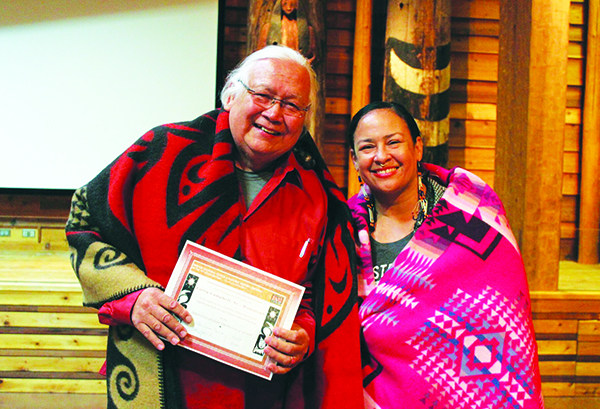
accept lifetime achievement awards at the Film Festival for their work in cultural sharing and filmmaking.
By Kalvin Valdillez, Tulalip News
Local filmmakers, cinephiles, culturalists and food fanatics gathered at the Hibulb Cultural Center on Saturday September 23, to attend the Center’s annual Film Festival. Every year the festival has a new theme and filmmakers are encouraged to submit a project correlating to the theme, however, all projects are welcome. The Cultural Center chose First Foods: Feeding our Spirits as the theme for this year’s festival.
Celebrating its fifth year, the festival featured a showing of several Indigenous films, a presentation by the Rediscovery Program and a story presented in Lushootseed by Natosha Gobin. Awards were presented to filmmakers in attendance as well as lifetime achievement awards to Swinomish elder Larry Campbell Sr. and Longhouse Media Director and Seminole/Choctaw tribal member Tracy Rector for their work in cultural sharing and filmmaking.
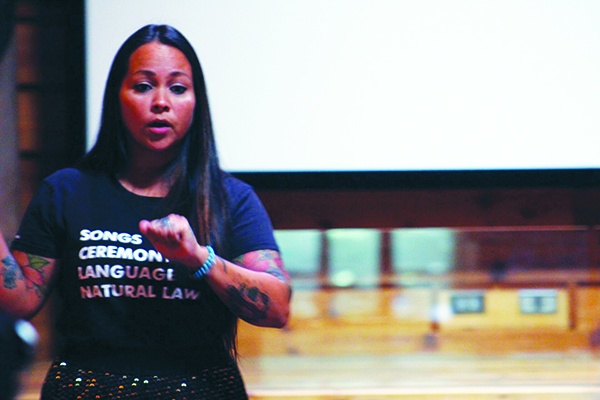
The Rediscovery Program shared the history of traditional Tulalip ancestral foods and a food tasting which included hawthorn horsetail peppermint tea, basil stinging nettle pesto, deer and elk meat, as well as mixed berries comprised of salal berries and mountain huckleberries. The Rediscovery Program also showcased a traditional bentwood box used for cooking. Inside the box were a variety of traditional foods, including mussels, oysters, clams, salmon, elk meat, berries and herbs; as well as cooking necessities such as cedar-woven food storage baskets, cooking rocks and utensils.
“It’s truly a blessing to be able to be one with our environment,” expresses Rediscovery Program Coordinator, Inez Bill. “We need to share that with our young people so they know that the lifeways of our people is very important to who we are. We need to see that continues to our grandchildren’s grandchildren. What’s important to know and remember is that our ancestors were one with their environment; and being one with the environment, they had a key identity with the resources. These natural resources provided for all of the needs for our people; it provided shelter, tools, transportation to go from one area to another. This relationship with the natural environment also meant that they respected the environment, they had teachings and values that they lived by. They had a spiritual connection that they followed daily.
“The spiritual connection, the teachings and the values were in all the lifeways of our people,” she continues. “Whether it was hunting, fishing or gathering it was done in a proper manner – with the rituals, making the baskets, carvings and all of the different teachings that took place. We had people that were so keen to the native plants that they were able to provide the medicine that was needed to help our people live. There were no hospitals; there was no fast food outside the reservation like there are now. Our people were a lot healthier than they are today. As our people adapted to the changing world, our bodies were not accustomed to these drastic changes and it’s not always in the best interest for our health. We need to do the best we can to continue to keep some of these foods, not for ourselves, but for the future generations. Because we know that when we eat our native foods we’re not only nourishing our bodies, we’re nourishing our spirits.”
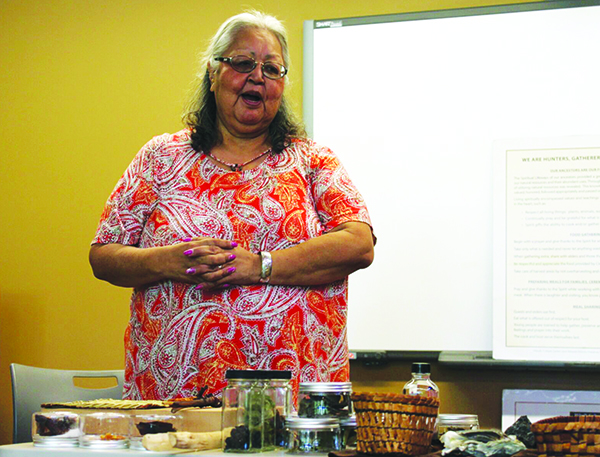
Following the presentation by the Rediscovery Program, festival attendees were treated to a viewing of eight films.
“We have categories in animation, documentaries long and short, feature films long and short, anti-bullying and experimental films,” explains Hibulb Cultural Center Education Curator and Film Festival Organizer, Lena Jones. “We have youth categories for animation, documentaries, feature films, anti-bullying, and experimental also. We have a section specific to Tulalip members in all those categories as well.”
Navajo Filmmaker Kody Dayish submitted three films for this year’s event. In his film The Beginning, a Navajo elder explains the heritage and traditions of the Navajo people to his grandson through traditional song. Kody also tackled serious issues such as bullying in schools and suicide during his three-minute film, Spared. For his third submission, Goodbye, a Navajo elder returns to her childhood home and is hit with a wave of nostalgia as she reminisces of young love in a music video-style film featuring music by Navajo band, Our Last Chants.
The Hibulb Cultural Center Film Festival also screened the short animation film, σčəδαδξʷ. The film’s name is in the traditional Lushootseed language, meaning salmon. The animation explains the importance of salmon to Coastal Natives while depicting the salmon’s lifecycle. The main character is the late Billy Frank Jr. and is told entirely in his voice, as the cartoon was built from one of his speeches.
“When I first saw [σčəδαδξʷ] I was at home reviewing all the films and I just cried,” states Swinomish tribal member and Hibulb Cultural Center Film Festival Judge, Robin Carneen. “Billy Frank Jr. was such a hero in our Northwest area because he was such a fighter for the rights of the people – treaty rights, our right to fish. He was on the ground to the day that he passed. That is such a powerful film. And to mix it as an animated film, it’s going to reach even younger generations. I grew up watching cartoons, not a lot of educational purpose to them except maybe for entertainment value and not necessarily always a good message. Later as an adult and watching animation, you think ‘wow all that was going into my brain?’ You see how much of an influence animation, films and TV are. To see Billy Frank again – he’s immortalized. His message is immortalized now, for all of us and all the generations yet to come so that we don’t quit fighting. This film is going to be our inspiration to make sure that fight keeps happening for generations to come.”
Tulalip tribal member, David Spencer Sr., presented his film, Waiting for Blackberries, which displayed clay Stick Indians chanting a traditional song to help ripen blackberries during the upcoming spring season. David was inspired to create the film when recalling advice from his grandmother to respect the berries, stating, “if you don’t show the berries respect, they will whip you with their thorny vines.”
The main screening, Maiden of Deception Pass: Guardian of her Samish People, was held in the Hibulb longhouse. The twenty-minute documentary highlighted the traditional story of Ko-kwal-alwoot, a young Samish woman who married a sea spirit in order to save her people from famine; and the erection of her story pole at Deception Pass in 1983. Filmmakers of the documentary include Jason Ticknor, Lou Karsen and Tracy Rector. Two international films, Hani’s Barbershop and Closer, were also shown to close out the festival.
“What I like about the Native films is that it’s really important that we’re preserving and documenting our culture,” says Robin. “When I see the language show up in the films, I get so excited to see and hear the language. That’s what I like about the films that are coming in from our area. The films are all so different but they’re all so important. The mix of people that we have, including the many generations, I think that all of the storytelling is great. Especially with all the modern technology, to mix the two together because it’s going to reach everybody on some level.”
The fifth Annual Hibulb Cultural Center Film Festival was a success as movie buffs from the Pacific Northwest, including Canada and Oregon, traveled to Tulalip for an afternoon of culture and movies. The event continues to generate interest as several young tribal members attended. Lena hopes to inspire indigenous youth to pick up a camera and start shooting.
“I encourage young people to become involved in filmmaking,” she states. “Films can impact people. We have such a strong, beautiful culture; and we have a belief that young people can reflect our ancestral values in film work because of their experience living in the culture. Plus, filmmaking is enjoyable!”
For additional information about the Annual Hibulb Cultural Center Film Festival please contact the museum at (360) 716-2600.
Screenagers sheds light on the impact of youth’s increased screen time
By Micheal Rios, Tulalip News
Raising youth in our technologically advanced society is a challenge for most caregivers technologywho struggle to understand the effects and how to set limits on their children’s screen time. Today’s youth are the first to be raised in the age of the smartphone, and its influence can be felt everywhere.
Smartphones, video games, and digital media have created new headaches for many families. Concepts like sexting, online bullying, video game addiction, and obsessive social media attachment have become common practice among today’s youth. Behaviors as these can often lead to disruptions in school and sleep, anti-social behavior, and depression. For parents and caregivers, the question of how to even begin addressing these concepts with their children seems like a daunting task.
In this context, Tulalip Youth Services invited youth and their parents to participate in a discussion of the topic and view the award-winning film, Screenagers: Growing Up in The Digital Age, on the evening of September 19. Screenagers is the first feature documentary to explore the impact of screen technology on kids and to offer parents proven solutions that work.
“Parents should always take the time to talk to their kids about the risks of technology, especially social media and using technology appropriately,” stated Teri Nelson, Youth Services Executive Director. “There are some great uses in the digital age that provide opportunities to learn and be creative, but with everything there needs to be moderation. I feel big concerns for our youth are online safety, privacy and reputation management with social media. One bad decision to post something inappropriate can have long-lasting, damaging effects.”
During the film’s screening there were 32 youth in attendance, plus several caregivers and Youth Services staff members.
Screenagers provided an in-depth, personal look at how families are coping with kids and screen time, the plot explored how being connected to devices is affecting relationships and even child development. Directed by Dalaney Ruston, a Seattle filmmaker and physician, the movie profiles her own family’s struggles with smart phones, social media, and video games. The film includes interviews with parents, teenagers, authors, psychologists and neuroscientists providing ideas on how we can empower ourselves to best navigate this digital world we live in.
Throughout the film, children and their parents are shown dealing with often serious consequences related to excessive screen time, or screen time without boundaries. Revealing stories that depict messy struggles over social media, video games, academics and internet addiction are shared.
A boy who lives with his grandmother becomes a “different child” when told he has to get off his video games. The grandmother seeks help for dealing with the confrontations.
Another boy, Andrew, is so consumed with playing video games into the wee hours during his freshman year of college that he stops going to classes and leaves school. He enters a rehabilitation facility to treat his addiction.
A girl with a love of photography spends most of her time in her room posing and taking pictures of herself to nurture a social identity aimed at getting “likes.”
Another girl, Hannah, shares a picture of herself in her bra with a boy she likes. When he shares the picture, the girl deals with the fallout at school and being bullied.
It’s not just the kids scrolling Facebook or Instagram or blasting away on the PlayStation that demand the attention of the filmmakers. Adults connected to work and their own social outlets through devices are called out by the very kids who they are attempting to digitally police.
“Can we really tell our kids, ‘Do as we say and not as we do’?” the film asks.
Interwoven into these stories, are cutting edge science and insights from thought leaders who present evidence on the real changes happening in the brain. For example, we are led to believe that through technology we can multitask. However, the truth is our brains aren’t built to multitask. We’re meant to focus on one thing at a time. Switching what’s on our screen from Facebook to Instagram to Twitter and inevitably back to Facebook , that back-and-forth raises levels of the hormone cortisol in our brains. Cortisol is the hormone produced when we are stressed. On top of that, every time you refresh any of your social media feeds, the brief burst of news or images gives you a quick dopamine hit, which activates the brain’s pleasure centers and leaves you wanting more. It’s a destructive cycle that can lead to addiction and an inability to stay unplugged and offline.
While our digital lifestyle is certainly not going anywhere, it’s critical to find a healthy balance between screen time and real-world interactions. In most cases, this means putting realistic restrictions on screen time for children and their parents.
Among community viewers at the film screening was tribal member Nickie Richwine and her three daughters. Following the movie, Nickie shared she already places restrictions on when and how her daughters can use their devices, but has learned additional methods of staying offline from the film.
“My girls are 15, 11 and 8-years-old. I took them all to see Screenagers because as a parent I believe that technology and electronic overuse prevents them from developing social skills that they’ll need as they become young adults,” says Nickie. “Face-to-face interaction is necessary to build healthy relationships with their peers. Texting and IM’ing is no substitute. My kids struggle to understand why I limit their screen time, but one of the main reasons I do is to protect them. Kids don’t understand the internet has a lot of dangers and potentially harmful exposures. I was hopeful that this film would help them understand that.”
Dexter Smith, 8th grader and junior rep for Tulalip Youth Council, was also present for the film and recognized some of his own behavior when it comes to video games. Dexter said he can get too caught up in video games and become angry, especially when he loses. He says he is going to work on that and adds, “I think people my age are on their phones too much when they could be enjoying the outdoors. My advice to youth out here is to stay off of inappropriate sites and not make posts hurtful to others.”
Two young ladies, who wished to remain anonymous, shared, “It’s become way easier to text someone than it is to have a conversation in person. We’re so attached to our phones that we don’t even realize we’re addicted to them. People are controlled by their phones and social media accounts, kids and adults. Even in school kids are constantly posting and updating through their phones during class. It’s a distraction from their education.”
Screenagers: Growing Up in the Digital Age probes into the vulnerable corners of family life, and delves into the messy family conflicts over social media, video games, academics and internet addiction. Only through self-reflection and an open dialogue do solutions emerge on how we can best empower young people to navigate the digital world. More information can be found at screenagersmovie.com.
The doctor’s prescription for limiting screen time
- Dr. Ruston suggests putting phones and other devices away at meal times, in the car and during family outings.
- While studying, teenagers should put their phones in another room but can take “tech breaks”.
- No phones, tablets or other devices in the bedroom when it’s time to sleep.
- Rather than relying on your phone, buy an alarm clock and a calculator.
- Limit interactive video games to certain times – the weekend, for example – especially for younger children.
- Try what a group of teenagers do in the film: when they eat out, they put their phones in the middle of the table. First to check their phone pays for dinner.
- Set aside regular time to calmly discuss any issues about mobile phones and other devices rather than letting them spark arguments.
- Parents worried about their children’s screen usage should think about what they are doing themselves.


